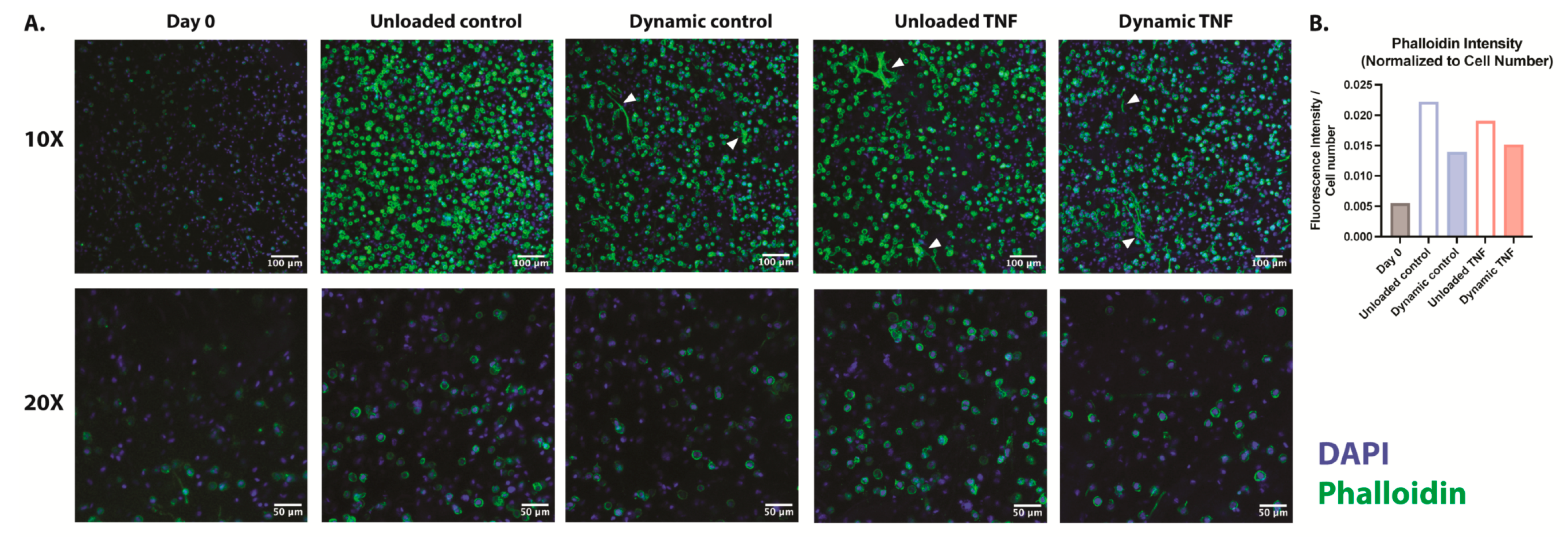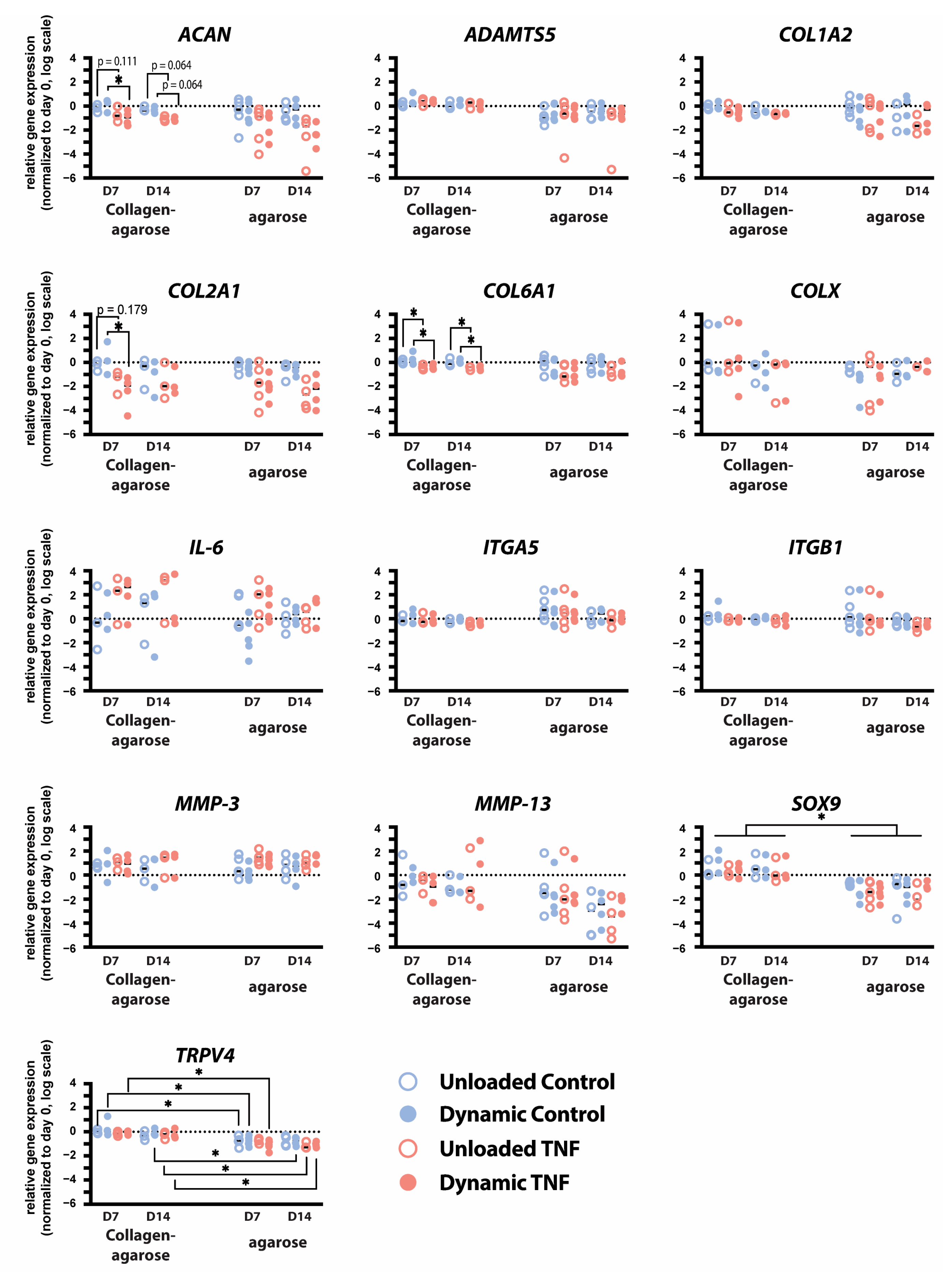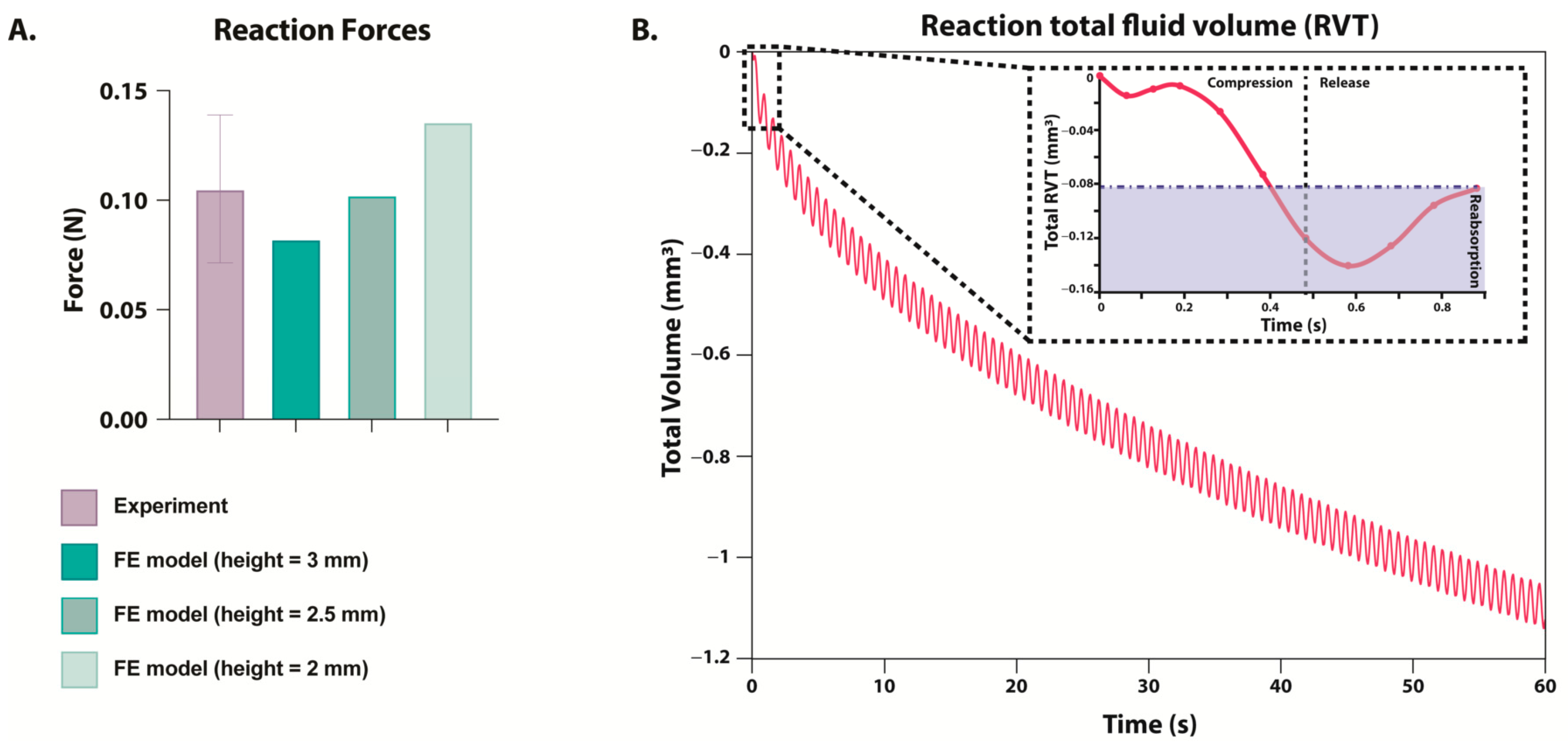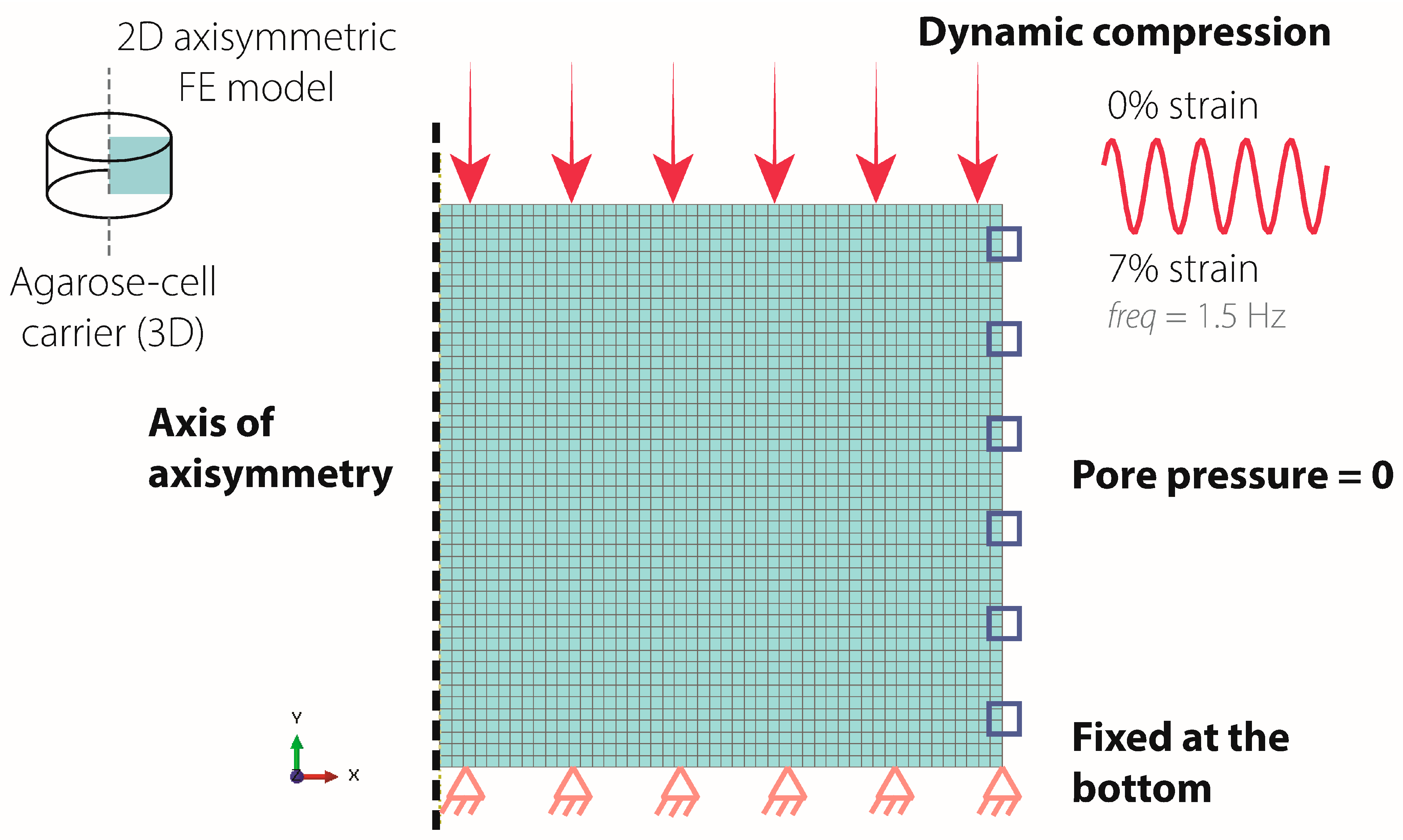Exploring Mechanotransduction and Inflammation in Human Cartilaginous Endplate Cells in Blended Collagen–Agarose Hydrogels Under Cyclic Compression
Abstract
1. Introduction
2. Results and Discussion
2.1. Blended Collagen–Agarose Hydrogels Are Stiffer than Agarose
2.2. Cell Viability Was Not Affected by TNF Treatment or Dynamic Compression
2.3. Cell Height Was Significantly Decreased During Culture
2.4. Human CEP Cells Retained Their Rounded Morphology
2.5. Cell Metabolism and GAG/DNA Content Remained Constant
2.6. Nitric Oxide (NO) Content
2.7. Anabolic Gene Exression Decreases in Response to TNF Stimulation
2.8. Reaction Forces of the Finite Element Model
2.9. Fluid Exchange Between the Models and the Surrounding Environment
2.10. Discussion
3. Conclusions and Limitations
4. Materials and Methods
4.1. Experimental Model and Study Participant Details
4.2. Human CEP Cell Isolation and Expansion
4.3. Hydrogel Fabrication and Culture
4.4. Stress–Strain Measurement
4.5. Height Measurement
4.6. Cell Viability
4.7. D Cell Morphology Imaging
4.8. Cell Metabolic Activity
4.9. GAG and DNA Quantification
4.10. RNA Extraction and qPCR
4.11. Nitric Oxide (NO) Content
4.12. Finite Element Model
4.13. Quantification and Statistical Analysis
Author Contributions
Funding
Institutional Review Board Statement
Informed Consent Statement
Data Availability Statement
Acknowledgments
Conflicts of Interest
Abbreviations
| ACAN | Aggrecan |
| ADAMTS5 | A disintegrin and metalloproteinase with thrombospondin motifs 5 |
| AF | Annulus fibrosus |
| cDNA | Complimentary DNA |
| CEP | Cartilaginous endplates |
| COL10A1 | Type X collagen |
| COL1A2 | Type I collagen |
| COL2A1 | Type II collagen |
| COL6A1 | Type VI collagen |
| E | Young’s modulus |
| ECM | Extracellular matrix |
| FAK | Focal adhesion kinase |
| FE | Finite element |
| GAG | Glycosaminoglycans |
| IL | Interleukin |
| IVD | Intervertebral disc |
| MMP | Matrix metalloproteinases |
| NP | Nucleus pulposus |
| PCM | Pericellular matrix |
| qPCR | Quantitative polymerase chain reaction |
| RVF | Reactive fluid volume flux |
| RVT | Reaction total fluid volume |
| SOX9 | SRY-Box Transcription Factor 9 |
| TNF | Tumor necrosis factor |
| TRPV4 | Transient receptor potential cation channel subfamily V member 4 |
References
- Bermudez-Lekerika, P.; Crump, K.B.; Tseranidou, S.; Nüesch, A.; Kanelis, E.; Alminnawi, A.; Baumgartner, L.; Muñoz-Moya, E.; Compte, R.; Gualdi, F.; et al. Immuno-Modulatory Effects of Intervertebral Disc Cells. Front. Cell Dev. Biol. 2022, 10, 924692. [Google Scholar] [CrossRef]
- Chan, S.C.W.; Ferguson, S.J.; Gantenbein-Ritter, B. The Effects of Dynamic Loading on the Intervertebral Disc. Eur. Spine J. 2011, 20, 1796. [Google Scholar] [CrossRef]
- Berger-Roscher, N.; Casaroli, G.; Rasche, V.; Villa, T.; Galbusera, F.; Wilke, H.J. Influence of Complex Loading Conditions on Intervertebral Disc Failure. Spine 2017, 42, E78–E85. [Google Scholar] [CrossRef]
- Wilke, H.J.; Kienle, A.; Maile, S.; Rasche, V.; Berger-Roscher, N. A New Dynamic Six Degrees of Freedom Disc-Loading Simulator Allows to Provoke Disc Damage and Herniation. Eur. Spine J. 2016, 25, 1363–1372. [Google Scholar] [CrossRef] [PubMed]
- Baumgartner, L.; Wuertz-Kozak, K.; Le Maitre, C.L.; Wignall, F.; Richardson, S.M.; Hoyland, J.; Ruiz Wills, C.; González Ballester, M.A.; Neidlin, M.; Alexopoulos, L.G.; et al. Multiscale Regulation of the Intervertebral Disc: Achievements in Experimental, In Silico, and Regenerative Research. Int. J. Mol. Sci. 2021, 22, 703. [Google Scholar] [CrossRef] [PubMed]
- Tsai, T.; Cheng, C.; Chen, C.; Lai, P. Mechanotransduction in Intervertebral Discs. J. Cell Mol. Med. 2014, 18, 2351–2360. [Google Scholar] [CrossRef]
- Le Maitre, C.L.; Frain, J.; Millward-Sadler, J.; Fotheringham, A.P.; Freemont, A.J.; Hoyland, J.A. Altered Integrin Mechanotransduction in Human Nucleus Pulposus Cells Derived from Degenerated Discs. Arthritis Rheum. 2009, 60, 460–469. [Google Scholar] [CrossRef]
- Gilbert, H.T.J.; Nagra, N.S.; Freemont, A.J.; Millward-Sadler, S.J.; Hoyland, J.A. Integrin–Dependent Mechanotransduction in Mechanically Stimulated Human Annulus Fibrosus Cells: Evidence for an Alternative Mechanotransduction Pathway Operating with Degeneration. PLoS ONE 2013, 8, e72994. [Google Scholar] [CrossRef] [PubMed]
- Hernandez, P.A.; Jacobsen, T.D.; Chahine, N.O. Actomyosin Contractility Confers Mechanoprotection Against TNFα-Induced Disruption of the Intervertebral Disc. Sci. Adv. 2020, 6, eaba2368. [Google Scholar] [CrossRef]
- Gilbert, H.T.; Hoyland, J.A.; Freemont, A.J.; Millward-Sadler, S.J. The Involvement of Interleukin-1 and Interleukin-4 in the Response of Human Annulus Fibrosus Cells to Cyclic Tensile Strain: An Altered Mechanotransduction Pathway with Degeneration. Arthritis Res. Ther. 2011, 13, R8. [Google Scholar] [CrossRef]
- DeLucca, J.F.; Cortes, D.H.; Jacobs, N.T.; Vresilovic, E.J.; Duncan, R.L.; Elliott, D.M. Human Cartilage Endplate Permeability Varies with Degeneration and Intervertebral Disc Site. J. Biomech. 2016, 49, 550–557. [Google Scholar] [CrossRef]
- Wu, Y.; Cisewski, S.E.; Sachs, B.L.; Pellegrini, V.D.; Kern, M.J.; Slate, E.H.; Yao, H. The Region-Dependent Biomechanical and Biochemical Properties of Bovine Cartilaginous Endplate. J. Biomech. 2015, 48, 3185. [Google Scholar] [CrossRef] [PubMed]
- Wu, Y.; Glaser, J.; Yao, H. Effects of Endplate and Mechanical Loading on Solute Transport in Intervertebral Disc. In Proceedings of the ASME Summer Bioengineering Conference, SBC2008, Marco Island, FL, USA, 25–29 June 2008; pp. 129–130. [Google Scholar] [CrossRef]
- Ruiz Wills, C.; Foata, B.; González Ballester, M.Á.; Karppinen, J.; Noailly, J. Theoretical Explorations Generate New Hypotheses About the Role of the Cartilage Endplate in Early Intervertebral Disk Degeneration. Front. Physiol. 2018, 9, 1210. [Google Scholar] [CrossRef] [PubMed]
- Dudli, S.; Sing, D.C.; Hu, S.S.; Berven, S.H.; Burch, S.; Deviren, V.; Cheng, I.; Tay, B.K.B.; Alamin, T.F.; Ith, M.A.M.; et al. ISSLS Prize in Basic Science 2017: Intervertebral Disc/Bone Marrow Cross-Talk with Modic Changes. Eur. Spine J. 2017, 26, 1362–1373. [Google Scholar] [CrossRef]
- Moore, R.J. The Vertebral End-Plate: What Do We Know? Eur. Spine J. 2000, 9, 92–96. [Google Scholar] [CrossRef]
- Roberts, S.; Menage, J.; Urban, J.P.G. Biochemical and Structural Properties of the Cartilage End-Plate and Its Relation to the Intervertebral Disc. Spine 1989, 14, 166–174. [Google Scholar] [CrossRef] [PubMed]
- Crump, K.B.; Kanelis, E.; Segarra-Queralt, M.; Pascuet-Fontanet, A.; Bermudez-Lekerika, P.; Alminnawi, A.; Geris, L.; Alexopoulos, L.G.; Noailly, J.; Gantenbein, B. TNF Induces Catabolism in Human Cartilaginous Endplate Cells in 3D Agarose Culture Under Dynamic Compression. Sci. Rep. 2025, 15, 15849. [Google Scholar] [CrossRef]
- Cambria, E.; Brunner, S.; Heusser, S.; Fisch, P.; Hitzl, W.; Ferguson, S.J.; Wuertz-Kozak, K. Cell-Laden Agarose-Collagen Composite Hydrogels for Mechanotransduction Studies. Front. Bioeng. Biotechnol. 2020, 8, 346. [Google Scholar] [CrossRef]
- Bougault, C.; Paumier, A.; Aubert-Foucher, E.; Mallein-Gerin, F. Molecular Analysis of Chondrocytes Cultured in Agarose in Response to Dynamic Compression. BMC Biotechnol. 2008, 8, 71. [Google Scholar] [CrossRef]
- Mauck, R.L.; Soltz, M.A.; Wang, C.C.B.; Wong, D.D.; Chao, P.-H.G.; Valhmu, W.B.; Hung, C.T.; Ateshian, G.A. Functional Tissue Engineering of Articular Cartilage Through Dynamic Loading of Chondrocyte-Seeded Agarose Gels. J. Biomech. Eng. 2000, 122, 252–260. [Google Scholar] [CrossRef]
- Bougault, C.; Paumier, A.; Aubert-Foucher, E.; Mallein-Gerin, F. Investigating Conversion of Mechanical Force into Biochemical Signaling in Three-Dimensional Chondrocyte Cultures. Nat. Protoc. 2009, 4, 928–938. [Google Scholar] [CrossRef]
- Ulrich, T.A.; Jain, A.; Tanner, K.; MacKay, J.L.; Kumar, S. Probing Cellular Mechanobiology in Three-Dimensional Culture with Collagen–Agarose Matrices. Biomaterials 2010, 31, 1875–1884. [Google Scholar] [CrossRef]
- Yamada, Y.; Hozumi, K.; Aso, A.; Hotta, A.; Toma, K.; Katagiri, F.; Kikkawa, Y.; Nomizu, M. Laminin Active Peptide/Agarose Matrices as Multifunctional Biomaterials for Tissue Engineering. Biomaterials 2012, 33, 4118–4125. [Google Scholar] [CrossRef]
- Bahcecioglu, G.; Hasirci, N.; Bilgen, B.; Hasirci, V. Hydrogels of Agarose, and Methacrylated Gelatin and Hyaluronic Acid Are More Supportive for In Vitro Meniscus Regeneration than Three Dimensional Printed Polycaprolactone Scaffolds. Int. J. Biol. Macromol. 2019, 122, 1152–1162. [Google Scholar] [CrossRef]
- Torabi Rahvar, P.; Abdekhodaie, M.J.; Jooybar, E.; Gantenbein, B. An Enzymatically Crosslinked Collagen Type II/Hyaluronic Acid Hybrid Hydrogel: A Biomimetic Cell Delivery System for Cartilage Tissue Engineering. Int. J. Biol. Macromol. 2024, 279, 134614. [Google Scholar] [CrossRef] [PubMed]
- Antich, C.; Jiménez, G.; de Vicente, J.; López-Ruiz, E.; Chocarro-Wrona, C.; Griñán-Lisón, C.; Carrillo, E.; Montañez, E.; Marchal, J.A. Development of a Biomimetic Hydrogel Based on Predifferentiated Mesenchymal Stem-Cell-Derived ECM for Cartilage Tissue Engineering. Adv. Healthc. Mater. 2021, 10, e2001847. [Google Scholar] [CrossRef] [PubMed]
- Jacobs, C.A.M.; Kamali, S.A.; Abdelgawad, A.M.; Meij, B.P.; Ghazanfari, S.; Tryfonidou, M.A.; Jockenhoevel, S.; Ito, K. Mechanical Characterization of a Novel Biomimetic Artificial Disc for the Cervical Spine. J. Mech. Behav. Biomed. Mater. 2023, 142, 105808. [Google Scholar] [CrossRef] [PubMed]
- Yuan, D.; Chen, Z.; Zhou, Y.; Xiao, D.; Liu, K.; Xiang, X.; Deng, L.; Dong, H.; Feng, G. Regenerative Intervertebral Disc Endplate Based on Biomimetic Three-Dimensional Scaffolds. Spine 2017, 42, E260–E266. [Google Scholar] [CrossRef]
- Jutila, A.A.; Zignego, D.L.; Schell, W.J.; June, R.K. Encapsulation of Chondrocytes in High-Stiffness Agarose Microenvironments for In Vitro Modeling of Osteoarthritis Mechanotransduction. Ann. Biomed. Eng. 2015, 43, 1132–1144. [Google Scholar] [CrossRef]
- Capuana, E.; Marino, D.; Di Gesù, R.; La Carrubba, V.; Brucato, V.; Tuan, R.S.; Gottardi, R. A High-Throughput Mechanical Activator for Cartilage Engineering Enables Rapid Screening of in Vitro Response of Tissue Models to Physiological and Supra-Physiological Loads. Cells Tissues Organs 2022, 211, 670–688. [Google Scholar] [CrossRef]
- Sanchez-Adams, J.; Leddy, H.A.; McNulty, A.L.; O’Conor, C.J.; Guilak, F. The Mechanobiology of Articular Cartilage: Bearing the Burden of Osteoarthritis. Curr. Rheumatol. Rep. 2014, 16, 451. [Google Scholar] [CrossRef]
- O’Conor, C.J.; Leddy, H.A.; Benefield, H.C.; Liedtke, W.B.; Guilak, F. TRPV4-Mediated Mechanotransduction Regulates the Metabolic Response of Chondrocytes to Dynamic Loading. Proc. Natl. Acad. Sci. USA 2014, 111, 1316–1321. [Google Scholar] [CrossRef] [PubMed]
- Muramatsu, S.; Wakabayashi, M.; Ohno, T.; Amano, K.; Ooishi, R.; Sugahara, T.; Shiojiri, S.; Tashiro, K.; Suzuki, Y.; Nishimura, R.; et al. Functional Gene Screening System Identified TRPV4 as a Regulator of Chondrogenic Differentiation. J. Biol. Chem. 2007, 282, 32158–32167. [Google Scholar] [CrossRef] [PubMed]
- Anderson, D.E.; Johnstone, B. Dynamic Mechanical Compression of Chondrocytes for Tissue Engineering: A Critical Review. Front. Bioeng. Biotechnol. 2017, 5, 302287. [Google Scholar] [CrossRef]
- DiMicco, M.A.; Kisiday, J.D.; Gong, H.; Grodzinsky, A.J. Structure of Pericellular Matrix Around Agarose-Embedded Chondrocytes. Osteoarthr. Cartil. 2007, 15, 1207–1216. [Google Scholar] [CrossRef][Green Version]
- Mauck, R.L.; Yuan, X.; Tuan, R.S. Chondrogenic Differentiation and Functional Maturation of Bovine Mesenchymal Stem Cells in Long-Term Agarose Culture. Osteoarthr. Cartil. 2006, 14, 179–189. [Google Scholar] [CrossRef]
- Tasci, A.; Ettinger, L.; Ferguson, S.; Büchler, P. The Role of Agarose Mechanical Response on the Matrix Synthesis of Nucleus Pulposus Cells: A Pilot Study. In Proceedings of the ASME 2009 Summer Bioengineering Conference, Parts A and B, Olympic Valley, CA, USA, 17–21 June 2009; American Society of Mechanical Engineers: New York, NY, USA, 2009; pp. 561–562. [Google Scholar]
- Frauchiger, D.; May, R.; Bakirci, E.; Tekari, A.; Chan, S.; Wöltje, M.; Benneker, L.; Gantenbein, B. Genipin-Enhanced Fibrin Hydrogel and Novel Silk for Intervertebral Disc Repair in a Loaded Bovine Organ Culture Model. J. Funct. Biomater. 2018, 9, 40. [Google Scholar] [CrossRef]
- Schindelin, J.; Arganda-Carreras, I.; Frise, E.; Kaynig, V.; Longair, M.; Pietzsch, T.; Preibisch, S.; Rueden, C.; Saalfeld, S.; Schmid, B.; et al. Fiji: An Open-Source Platform for Biological-Image Analysis. Nat. Methods 2012, 9, 676–682. [Google Scholar] [CrossRef] [PubMed]
- Croft, A.S.; Roth, Y.; Oswald, K.A.C.; Ćorluka, S.; Bermudez-Lekerika, P.; Gantenbein, B. In Situ Cell Signalling of the Hippo-YAP/TAZ Pathway in Reaction to Complex Dynamic Loading in an Intervertebral Disc Organ Culture. Int. J. Mol. Sci. 2021, 22, 13641. [Google Scholar] [CrossRef]
- Tasci, A.; Ferguson, S.J.; Büchler, P. Numerical Assessment on the Effective Mechanical Stimuli for Matrix-Associated Metabolism in Chondrocyte-Seeded Constructs. J. Tissue Eng. Regen. Med. 2011, 5, 210–219. [Google Scholar] [CrossRef]
- Gu, W.Y.; Yao, H.; Huang, C.Y.; Cheung, H.S. New Insight into Deformation-Dependent Hydraulic Permeability of Gels and Cartilage, and Dynamic Behavior of Agarose Gels in Confined Compression. J. Biomech. 2003, 36, 593–598. [Google Scholar] [CrossRef] [PubMed]






| Donor # | Gender | Age (Years) | Location |
|---|---|---|---|
| 1 * | Female | 42 | L2/L3 |
| 2 * | Male | 35 | L4/L5 |
| 3 | Male | 28 | L3/L4 |
| 4 | Male | 32 | Th11/12 |
| 5 | Female | 22 | Th11/12 |
| Gene Type | Gene (Gene Abbreviation) | Gene ID | Forward and Reverse Primer Sequence |
|---|---|---|---|
| Reference Gene | 18S | 18S | f- CGA TGC GGC GGC GTT ATT Cr- TCT GTC AAT CCT GTC CGT GTC C |
| Anabolic Markers | Aggrecan | ACAN | f- CAT CAC TGC AGC TGT CACr- AGC AGC ACT ACC TCC TTC |
| Type Icollagen | COL1A2 | f- GTG GCA GTG ATG GAA GTGr- CAC CAG TAA GGC CGT TTG | |
| Type II collagen | COL2A1 | f- AGC AGC AAG AGC AAG GAG AAr- GTA GGA AGG TCA TCT GGA | |
| Type VI collagen | COL6A1 | f- TTCAAGGAGGCTGTCAAGAACr- TGATGAGGCGGTCGTAGG | |
| SRY-Box Transcription Factor 9 | SOX9 | f- GAG ACT TCT GAA CGA GAGr- GCT CTG ATG TGT TGA AGA AC | |
| Catabolic Markers | A disintegrin and metalloproteinase with thrombospondin motifs 5 | ADAMTS5 | f- GCT GTG CTG TGA TTG AAG Ar- TGC TGG TAA GGA TGG AAG A |
| Matrix metalloproteinase-3 | MMP-3 | f- CAA GGC ATA GAG ACA ACA TAG Ar- GCA CAG CAA CAG TAG GAT | |
| Interleukin 6 | IL6 | f- GCC ACT CAC CTC TTC AGA ACr- GCA AGT CTC CTC ATT GAA TCC A | |
| Type X collagen | COLX | f- GAA TGC CTG TGT CTG CTTr- TCA TAA TGC TGT TGC CTG TTA | |
| Mechanoreceptors | Transient receptor potential cation channel subfamily V member 4 | TRPV4 | f- GTT GGT CTG GTC CTC ATT Gr- GAT TCC TGC TCG TCT ACT TG |
| Integrin Subunit Alpha 5 | ITGA5 | f- ATC GCT CTC AAC TTC TCC TTr- CGG CTC TTG CTC TGA TAA TG | |
| Integrin Subunit Beta 1 | ITGB1 | f- CCT TGG TGT CTG TGC TGAr- GTC GTC AAC ATC CTT CTC CTT AC |
Disclaimer/Publisher’s Note: The statements, opinions and data contained in all publications are solely those of the individual author(s) and contributor(s) and not of MDPI and/or the editor(s). MDPI and/or the editor(s) disclaim responsibility for any injury to people or property resulting from any ideas, methods, instructions or products referred to in the content. |
© 2025 by the authors. Licensee MDPI, Basel, Switzerland. This article is an open access article distributed under the terms and conditions of the Creative Commons Attribution (CC BY) license (https://creativecommons.org/licenses/by/4.0/).
Share and Cite
Crump, K.B.; Chapallaz, C.; Alminnawi, A.; Bermudez-Lekerika, P.; Geris, L.; Noailly, J.; Gantenbein, B. Exploring Mechanotransduction and Inflammation in Human Cartilaginous Endplate Cells in Blended Collagen–Agarose Hydrogels Under Cyclic Compression. Gels 2025, 11, 736. https://doi.org/10.3390/gels11090736
Crump KB, Chapallaz C, Alminnawi A, Bermudez-Lekerika P, Geris L, Noailly J, Gantenbein B. Exploring Mechanotransduction and Inflammation in Human Cartilaginous Endplate Cells in Blended Collagen–Agarose Hydrogels Under Cyclic Compression. Gels. 2025; 11(9):736. https://doi.org/10.3390/gels11090736
Chicago/Turabian StyleCrump, Katherine B., Chloé Chapallaz, Ahmad Alminnawi, Paola Bermudez-Lekerika, Liesbet Geris, Jérôme Noailly, and Benjamin Gantenbein. 2025. "Exploring Mechanotransduction and Inflammation in Human Cartilaginous Endplate Cells in Blended Collagen–Agarose Hydrogels Under Cyclic Compression" Gels 11, no. 9: 736. https://doi.org/10.3390/gels11090736
APA StyleCrump, K. B., Chapallaz, C., Alminnawi, A., Bermudez-Lekerika, P., Geris, L., Noailly, J., & Gantenbein, B. (2025). Exploring Mechanotransduction and Inflammation in Human Cartilaginous Endplate Cells in Blended Collagen–Agarose Hydrogels Under Cyclic Compression. Gels, 11(9), 736. https://doi.org/10.3390/gels11090736









